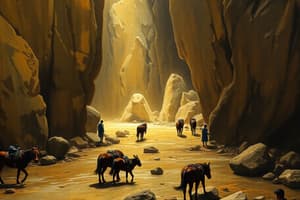Podcast
Questions and Answers
Which environmental consequence is most directly associated with mountaintop removal mining?
Which environmental consequence is most directly associated with mountaintop removal mining?
- Elevated levels of mercury in the atmosphere
- Increased risk of mine shaft collapses.
- Depletion of deep coal deposits.
- Significant habitat destruction and stream turbidity. (correct)
What is the primary reason subsurface mining is becoming more prevalent?
What is the primary reason subsurface mining is becoming more prevalent?
- It has a lower initial investment compared to surface mining.
- It is less damaging to the landscape compared to surface mining.
- Surface coal deposits are becoming exhausted. (correct)
- It eliminates the risk of acid mine drainage.
Acid mine drainage is formed when rainwater interacts with which of the following?
Acid mine drainage is formed when rainwater interacts with which of the following?
- Asbestos found in subsurface mines.
- Pyrite in abandoned mine tunnels. (correct)
- Methane gas released from coal seams.
- Overburden rich in organic matter.
What is a key difference in the risks associated with surface mining and subsurface mining?
What is a key difference in the risks associated with surface mining and subsurface mining?
What is the primary purpose of venting methane gas from coal mines?
What is the primary purpose of venting methane gas from coal mines?
How does acid mine drainage affect aquatic ecosystems?
How does acid mine drainage affect aquatic ecosystems?
What is the term used to describe the soil, vegetation, and rock removed to access ore deposits during mining operations?
What is the term used to describe the soil, vegetation, and rock removed to access ore deposits during mining operations?
Which of the following is a direct consequence of increased particulate matter (PM) in the air due to mining activities?
Which of the following is a direct consequence of increased particulate matter (PM) in the air due to mining activities?
Which factor most significantly determines whether a mineral deposit is classified as a commercially viable ore?
Which factor most significantly determines whether a mineral deposit is classified as a commercially viable ore?
A country's reliance on imports for strategic minerals like manganese, cobalt, and platinum suggests:
A country's reliance on imports for strategic minerals like manganese, cobalt, and platinum suggests:
What is the primary distinction between 'high-grade' and 'low-grade' ore deposits?
What is the primary distinction between 'high-grade' and 'low-grade' ore deposits?
What is 'gangue' in the context of mining?
What is 'gangue' in the context of mining?
Why are rare earth elements (REEs) considered critical for a 'greener economy'?
Why are rare earth elements (REEs) considered critical for a 'greener economy'?
The concept of 'economic depletion' in mineral resources suggests that:
The concept of 'economic depletion' in mineral resources suggests that:
What process describes the use of heat and chemicals to convert mined ore into a usable form?
What process describes the use of heat and chemicals to convert mined ore into a usable form?
If a mine ceases operation because the cost of extracting the remaining minerals exceeds their market value, this is an example of:
If a mine ceases operation because the cost of extracting the remaining minerals exceeds their market value, this is an example of:
Flashcards
Ore
Ore
Commercially valuable mineral deposits harvested for raw materials.
Metals
Metals
Elements that conduct electricity and heat, useful for building.
Reserves
Reserves
The estimated amount of a resource left that can be mined, often in years.
Rare Earth Elements (REEs)
Rare Earth Elements (REEs)
Signup and view all the flashcards
Low Grade Ore
Low Grade Ore
Signup and view all the flashcards
High Grade Ore
High Grade Ore
Signup and view all the flashcards
Gangue
Gangue
Signup and view all the flashcards
Smelting
Smelting
Signup and view all the flashcards
Surface Mining
Surface Mining
Signup and view all the flashcards
Overburden
Overburden
Signup and view all the flashcards
Subsurface Mining
Subsurface Mining
Signup and view all the flashcards
Mountaintop Removal
Mountaintop Removal
Signup and view all the flashcards
Environmental Impact of Mountaintop Removal
Environmental Impact of Mountaintop Removal
Signup and view all the flashcards
Acid Mine Drainage
Acid Mine Drainage
Signup and view all the flashcards
Acid Mine Drainage Consequences
Acid Mine Drainage Consequences
Signup and view all the flashcards
Methane Release
Methane Release
Signup and view all the flashcards
Study Notes
Mining Overview
- Mining involves harvesting and collecting commercially valuable mineral deposits known as ore for use as raw materials.
- Metals, which are extracted through mining, are elements that conduct electricity and heat, beneficial for construction.
- Reserves refer to the quantity of minerals left that can be mined, usually measured by years of extraction remaining.
- Approximate global and U.S. metal reserve supplies vary; for example, aluminum has 100 years globally versus 2 years in the U.S., while cobalt has 50 years globally and 95 years in the U.S.
Mineral Supply
- There are bountiful supplies of iron and aluminum.
- Deposits of certain materials like chromium, manganese, cobalt, and platinum are limited.
- Uneven global distribution of mineral deposits often requires international trade agreements.
- The U.S., Canada, Russia, South Africa, and Australia supply nonrenewable minerals to much of the world.
- Per capita mineral usage has sharply increased since the 1950s.
- Over 50% of the 24 most critical nonrenewable mineral resources in the U.S. are imported.
- Manganese, cobalt, chromium, and platinum are strategic resources.
- The actual and potential mineral supply, and the rate at which they are used are factors to consider.
- The economic depletion of mineral sources will occur before they are completely exhausted because the cost to extract will be greater than the market price achieved.
Rare Earth Elements (REEs)
- REEs are a group of metals crucial for a greener economy, making reserve locations very valuable.
- The 17 silvery-white soft heavy metals, also called rare earth metals, rare earth oxides, or lanthanides, are used in electronics through catalysts, magnets, special metal alloys, glass, and high-performance electronics.
Global Supply of EU Critical Minerals and Metals
- China leads in the world's reserves and mine production of rare earth elements.
- Although the U.S. has 1.5 million tons in reserves, it still relies on China to refine rare earths.
- Vietnam and Brazil have the second and third most reserves, but their mine production is among the lowest at 1,000 tons per year each.
- The biggest share of U.S. imports from China are for: Yttrium, Beryllium, Borate, Rare earth compounds and metals.
- China accounts for, on average between 2018-2021, 74% of U.S. imports of Bismuth.
Mining Grades
- Low grade ore is a deposit mixture with a small amount of the desired ore.
- High grade ore is a deposit with a high amount of the desired mineral.
- In order for mining to be worthwhile, it must be profitable.
- Gangue is the term given to worthless material that surrounds the ore.
- Smelting is a process using heat and chemicals to make ore into usable material.
Mining: Advantages vs. Disadvantages
- Advantages of mining include income and profit from extracted materials, revenues for cities, states, and countries, and job creation.
- Disadvantages include high energy consumption, soil erosion, habitat destruction, and the production of waste, air, water, and soil pollution.
Surface Mining
- This method involves removing the overburden to access the ore underneath and include: Open pit, strip, mountaintop removal, and placer.
- The process can be very damaging to the landscape, habitats, and streams.
- 90% of nonfuel/rock resources, and up to 60% of coal resources are obtained through surface mining.
Mountain Top Removal
- This process includes the removal of vegetation and soil.
- This leads to topsoil erosion, habitat loss, increased stream turbidity, and increased particulate matter in the air.
- Underground mining is needed as surface ore becomes harder to find.
Subsurface Mining
- Subsurface mining is employed for deep coal deposits and metal ores.
- Higher costs for workers, insurance, and healthcare make it more expensive.
- Risks include poor ventilation, leading to toxic gas exposure, mine shaft collapses, lung cancer (Black lung), asbestos exposure, fires, and explosions.
- Subsurface mining is increasingly needed as surface coal deposits are depleted.
Environmental Impact
- Rainwater can carry sulfuric acid into nearby streams or groundwater.
- The pH of water is lowered, making toxic metals like Hg and Al more soluble.
- Coal mining releases methane gas (CH4) from rock around coal.
- Methane vented out of mines avoids explosions but continues even after mine closure.
- PM releases soot and other particulates, causing lung irritation for both humans and animals.
- Acid mine drainage occurs as rainwater leaks into abandoned mine tunnels and mixes with pyrite to form sulfuric acid.
Mining Leftovers
- Overburden describes soil, vegetation, and rock removed to access the ore deposit underneath.
- Tailings and slag are leftover waste material separated from the valuable metal or mineral within ore, usually stored in ponds and water holds at mine sites.
Mine Reclamation
- The process restores land back to its original state after mining.
- This includes filling empty mine shafts and holes.
- Original contours need to be restored.
- Topsoil, with acids, metals, and tailings removed, is returned.
- Replanting native plants helps restore the community to its original state.
Surface Mining Control and Reclamation Act of 1977
- This act established a program for regulating surface coal mining and reclamation activities.
- Mandatory uniform standards are established for these activities on state and federal lands to minimize impacts on fish, wildlife, and related environmental concerns.
- The act creates an abandoned mine reclamation fund for reclaiming and restoring land and water resources adversely affected by coal mining.
Studying That Suits You
Use AI to generate personalized quizzes and flashcards to suit your learning preferences.




